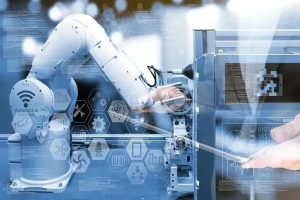When Sany was first established, it caught up with the rapid development of China’s urbanization.
After 2008, affected by the international financial crisis, the government’s “four trillion plan” was introduced, driving China’s infrastructure boom, the real estate industry is also unstoppable. Building roads, building houses, all need to use construction machinery. Sany Heavy Industry in 2011 ushered in the high moment, the market value had reached 150 billion yuan.

From 2012 onwards, macro-stimulus policies gradually withdrew, industry competition intensified, Sany’s performance declined year by year.
In 2015 and 2016, there was even a loss that had not been seen for years.
Then, until 2020, Sany’s market value reached 150 billion again. This was almost a decade apart.

The biggest inspiration that Sany has got from this experience is to counteract the cyclical fluctuations with the help of digital transformation.

Typical cyclical industry like construction machinery, will certainly experience the ebb and flow.
Do you want to lay off employees when the market is in the doldrums?
If you lay off employees, then when the market recovers and then try to recruit, it will be difficult to recruit people. Even if you can recruit people, the new employees may not be able to keep up with the skill level.
And what if there are no layoffs? Companies can’t afford to keep a lot of idle people in the most difficult times.
How to do?
Sany’s new idea is: on the robot.

Sany started using welding robots and cutting robots back in 2008.
Over the years, the cost of welders is getting higher and higher, and the salary of welders has increased from three to four thousand dollars to more than 10,000, but the cost of welding robots is decreasing.
It used to take at least 800,000 yuan to buy a welding robot, but now it only costs 200,000 to 300,000 yuan.
Buying a robot will pay for itself in just over a year.
When the market is bad, you don’t need to worry about the robot “leaving”. When the orders are not enough, two of the ten machines are open, and the remaining eight just need to do a good job of maintenance.
Sany found that even the initial digitalization of intelligent manufacturing can help companies to speed up the response time and better iron out the fluctuations of the cycle.
However, Sany’s digital transformation has gone beyond having machines to replace manual labor in certain processes. CCTV’s “Morning News”, “East Time” and many other columns frequently mention the “excavator index”, which reflects the start-up and operation of various types of construction machinery and equipment, known as “China’s infrastructure barometer”. This index is provided by Sany Heavy Industry.
Heavy machinery such as excavators, cranes, mixers, rollers, etc., give the impression of being bulky and heavy, not too “high-tech”, but now the heavy machinery and equipment are equipped with sensors, they are in real-time collection of equipment trajectory and work status, these data will be transmitted back to the back-end industrial Internet platform, which can be remotely monitored and maintenance.
All traditional equipment today can be transformed into “digital products” through digital transformation (Digital Innovation Management: A Practical Framework (3)).
The largest industrial Internet platform for construction machinery in China is Shugen Internet invested by Sany Heavy Industry.
On Shugen Internet’s ROOTCLOUD platform, there are more than 800,000 connected devices, more than 5,000 types of machine access, and more than 1,100 types of industrial protocols supported.
The “Excavator Index” reported by CCTV was launched based on the data on Shugen Internet platform.
More than ten years ago, Sany started to add sensors to its own heavy machinery. At that time, it was for a particularly simple purpose, which was to prevent a very small number of customers from maliciously defaulting on their payments.
Heavy machinery is very expensive, less tens of thousands, more hundreds of thousands, millions, many customers will choose to pay in installments.
Sany Heavy Industry to the machine after the installation of sensors, real-time data transmission back, you can grasp where the equipment, how the use of the situation, so as to determine whether the customer malicious default, whether the “lock” operation and so on.
Later, Sany found that this IOT system actually has a bigger role to play.
For example, in the repair and maintenance of machinery and equipment. When there was a problem with the original equipment, they could only check the fault through the data returned after the customer reported the problem.
With this system, they can determine the problem of the equipment in advance of the customer and maintain it in advance based on the accumulated data and algorithm.
Then later, Trinity discovered that this system could also be used to observe macroeconomic conditions. For example, if only large machines are operating and small machines are not active, it indicates that more large infrastructure projects, mainly state-owned investments, are launched, while fixed asset investments by SMEs are not yet up.
Another example is that construction is done in stages.
The first stage is to do land leveling and anti-infiltration treatment, and the machines used are excavators, rollers, etc.
The second stage is to do ground infrastructure and pipeline laying, using machines such as mixers and concrete pumps.
The third stage is to do construction installation, and the machines used are mainly cranes and other lifting equipment.
In other words, through the work data of different machines, not only can we see the start of construction, but also can see which project is in what progress. Sany organized these data to the Ministry of Industry once a week, and later became the “excavator index”.

Around 2015, Industry 4.0, Industrial Internet and other concepts exploded, Sany found that the system they do, is not the industrial Internet platform?
The concept of industrial Internet was first proposed by the United States General Electric, Sany Heavy Industry made a comparison between itself and General Electric, and found that there are many similarities.
They both make large power machinery, and both are doing remote monitoring and predictive maintenance on machinery, Sany has the opportunity to develop an industrial Internet platform, which is later known as Shugen Internet.
The “Magic Quadrant for Global Industrial Internet Platforms Report” released by Gartner, a leading IT research firm, is a vane for the global industrial Internet community. Shugen Internet from 2019 to 2021, for three consecutive years to become the only Chinese companies selected.
Sany Heavy Industry, the leader of traditional heavy machinery, successfully grew out of the second curve and became the leading industrial Internet platform in China.
We can return to this theoretical framework once again.
Looking back at Sany’s evolutionary path: from supply chain perspective to value chain perspective to value network perspective, thus evolving traditional mechanical products to intelligent products (machinery + sensors), intelligent systems (cloud) and intelligent ecology (network) ……